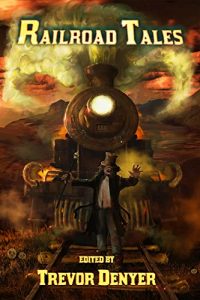
© Midnight Street Press
My short story Ballyshannon Junction is featured in the recent anthology Railroad Tales, edited by Trevor Denyer and published by Trevor’s Midnight Street Press. Railroad Tales is a collection of stories ‘involving railroads, trains, stations, junctions and crossings’ that also involve the ‘horrific, supernatural or extraordinary’. For that reason, Ballyshannon Junction is attributed to the pseudonym Jim Mountfield, the penname I attach to my macabre fiction. (Well, my real name ‘Ian Smith’ hardly sounds as evocative as, say, ‘Edgar Allan Poe’ or ‘H.P. Lovecraft’ or even ‘Dean R. Koontz’.)
Ballyshannon Junction had a long gestation period. It’s rooted in my childhood in Northern Ireland when, up until the age of eight or nine years old, I was lucky enough to have a former railway station as my personal playground. My family were farmers and, after my parents got married, my grandparents decided to move out of the family farmhouse to let their son and new daughter-in-law get on with the running of the farm. They bought the nearby Bundoran Junction, a former railway-station building and its surroundings that’d last seen trains in 1957 when the Irish Northwest line was closed, and they lived there in retirement.
The property had two platforms, one by the line to Enniskillen in County Fermanagh and one by the line to the seaside town of Bundoran in County Donegal. My grandfather planted trees along one line and filled in part of the other to create a lawn. I often spent the day there, or stayed with my grandparents overnight, and the place was like catnip to my young imagination. The station house had a glasshouse-like annex that I’d always thought was the old waiting room, although I’ve recently learned that it operated as a ‘refreshment room’. In addition, there were sheds, a pavilion building, a pond whose water was presumably used for filling the old steam locomotives and, best of all for a kid like me, an intact signal box with a staircase leading up to it – great for playing at being soldiers, knights, the Foreign Legion, the US Cavalry or anything else that might require a fort. I also remember a section of rusty metal wall that, according to this website, had once been the station’s urinal and, obstinately, still stands today.
Just to make the Junction seem more exotic still, the strip of ground behind the station building, between the two platforms and lines, was covered in trees. This belt of woodland was only a few metres wide, but to someone of my small size and immaturity it seemed like a dense forest.
In the mid-1970s, my grandparents relocated to the village of Ballinamallard, three miles away, and Bundoran Junction was bought by a retired clergyman, the Reverend Robert Simmons, and his family. However, after that, I remained a regular face at the Junction because I was at school with the Simmons’ two sons and sometimes got invited to visit them.
I’d been trying to use my memories of the Junction as the basis for a story since my teens. In fact, when I was 16, I wrote the first 20 pages of a story wherein a young homeless man, wandering about the countryside, stumbles across a disused railway line and starts living in an old signal box. There were no station building or platforms in the story, and I added a railway tunnel, but otherwise the setting was identical to Bundoran Junction. (The story’s premise was that the young man became convinced that something hideous and evil was lurking in the tunnel. He’d even find weird slimy footprints in the mornings, leading up the stairs to the door of the signal box, which suggested the thing was stalking him. But – curses! – I could never figure out what the thing in the tunnel actually was and eventually I abandoned the story.)
In the years since, I’ve tried several times to write other stories based on the Junction, but with a similar lack of success. Then, earlier this year, when Trevor Denyer announced that Railroad Tales was open for submissions, I decided to try again.
It also occurred to me that with my previous attempts at Junction stories, I’d always set the action not in Northern Ireland, but in some anonymous, generic tract of the English countryside. This time, I thought, why not write something about Bundoran Junction that’s actually set in Northern Ireland? To my surprise, I got the story finished and, to my immense satisfaction, it was accepted for Railroad Tales.
Not only does Ballyshannon Junction – Ballyshannon is a town in Donegal that’s close to Bundoran, the place that the real Junction was named after – take place in Northern Ireland, but it’s set in the year 1982, which wasn’t long after the period when I played there as a kid. For that reason, although it contains supernatural elements, Ballyshannon Junction is also informed by the mistrust, conflict, sectarianism and terrorism that blighted Northern Ireland at the time.
309 pages long, and bringing together 23 weird and creepy stories with a railway theme, Railroad Tales can be purchased through Amazon UK, here.

From eadiemcfarland.co.uk
